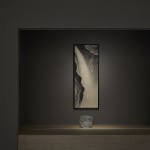Kawai Gyokudō (1873−1957)
Waterfall
Ink on silk, framed
Seal: Guan
135 x 50 cm
139 x 54 cm (overall)
Further images
To depict a waterfall, to say it precisely, is to capture a fleeting moment of its ever-changing faces. A number of paintings approach the subject of formless yet palpable water: a masterpiece Waterfall by Maruyama Okyo in the Shokoku-ji Temple depicts the rolling waves at the basin of waterfall; another waterfall painting by Takeuchi Seiho, who is presumably aware of photography, demonstrates the artist’s mastery of line, ink, and even the stroke movements that diffuse on the absorbent paper. Speaking of the present work by Kawai Gyokudo, a section of the silk ground is left unpainted so as to represent a sheet of fall; moreover, the draining power of the falling water is excellently demonstrated through the thin ink lines applied on two sides of the fall. Meanwhile, in the lower left a gradual transition from the shadowy back of the cliff to the sunlit front is represented through thick and thin application of ink, depicting the very existence of light. Gyokudo once stated, “Before producing works, I dig into classics and sketch nature with humility. I express what I learn from classics and nature in my works with humility. There is no other way.” The present work could be regarded in response to his endeavor to study the masterpieces and ceaselessly sketch the falls in life.
Kawai Gyokudo (nihonga painter; 1873−1957)
Also known as Guan.
Aichi-born nihonga painter. His real name is Yoshisaburo. Studied under Mochizuki Gyokusen, Kono Bairei, and Hashimoto Gaho. Established a unique style with poetic expressions. Recognized as three exceptional nihonga masters in Japan together with Yokoyama Taikan and Takeuchi Seiho. Member of Imperial Fine Art Academy, and designated as an Imperial Court Artist and a Person of Cultural Merit. Received the Order of Culture.
Kawai Gyokudo (nihonga painter; 1873−1957)
Also known as Guan.
Aichi-born nihonga painter. His real name is Yoshisaburo. Studied under Mochizuki Gyokusen, Kono Bairei, and Hashimoto Gaho. Established a unique style with poetic expressions. Recognized as three exceptional nihonga masters in Japan together with Yokoyama Taikan and Takeuchi Seiho. Member of Imperial Fine Art Academy, and designated as an Imperial Court Artist and a Person of Cultural Merit. Received the Order of Culture.





